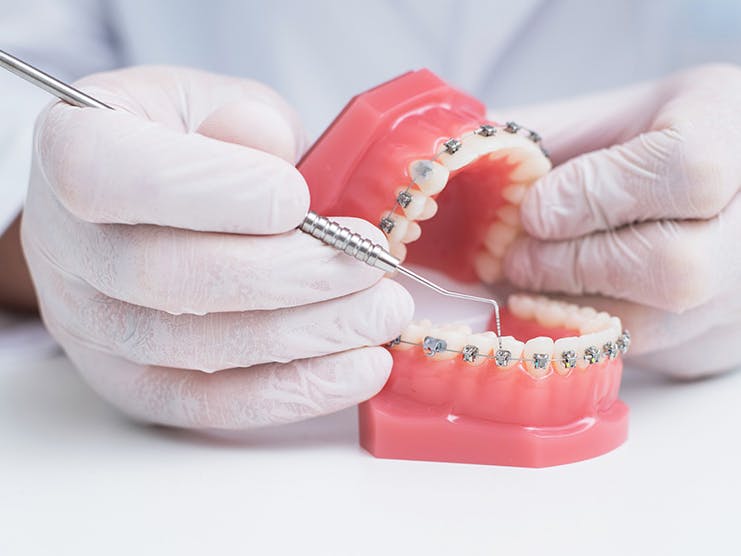
Original Medicare does not cover many dental services, but there are exceptions.
The position of your teeth and bite can change naturally over time, so even if you had braces as a child, you may find the need to get them again as an adult. Crooked teeth or a misaligned bite can make it difficult to chew food or maintain proper oral hygiene, can increase the risk of wearing down tooth enamel, and can make you more vulnerable to breakage or tooth decay.
Treating these abnormalities is a type of dentistry called orthodontia, and orthodontists are the providers who evaluate your needs and perform these procedures. However, prior to seeing an orthodontist, it’s important that Medicare beneficiaries understand their options if they need or want braces because typically, orthodontic procedures are not covered.
How much do braces cost?
The cost of braces can depend on a number of factors such as:
- Where you live
- Your age
- How much adjustment your teeth need
- The type of braces you get
- How long you’ll need braces for
- The orthodontist
- If there’s ever any damage to the braces
For example, conventional braces cost between $3,000 to $8,500 (depending on if they are metal or ceramic). Aligners can range from $3,000 to $7,000, and lingual braces can cost from $5,000 to $13,000.
Your out-of-pocket cost depends on whether you have an MA or an ancillary plan that covers braces, and what their coverage is. For example, your plan may cover 50% of the cost of basic braces but won’t cover aligners. Or, your plan may cover a portion of the cost and you’d be responsible for the remainder.
If you have Original Medicare only, you’ll be responsible for the full cost out-of-pocket.
Medicare coverage for braces
Braces and other dental and orthodontic care are not covered by Medicare Part A or Part B. This includes cleanings, fillings, tooth extractions, dentures, dental plates, dental implants, and braces.
The exception is if an accident or disease requires a restorative orthodontic procedure or orthodontic treatment, the procedure and/or braces may be considered medically necessary and covered.
Additionally, if an emergency or surgical orthodontic procedure requires a hospital stay, associated inpatient costs may be covered by Part A (though costs directly related to the orthodontic procedure are not covered).
Learn more: Are Dental Services Covered by Medicare?
Do Medicare Advantage plans cover braces?
Medicare Advantage (Part C) plans are offered by private insurance companies and are required to cover everything Original Medicare Part A and Part B do. These plans also offer additional benefits such as Part D prescription drug coverage, vision, and hearing benefits.
Many MA plans also offer dental coverage. While these benefits typically cover routine dental services, such as cleanings, fillings, and X-rays, some plans may also offer expanded dental benefits that cover braces and other orthodontic procedures. Check the dental benefits or contact the plan directly to understand your options and learn about any costs associated with dental care.
Does Medigap cover braces?
Medicare Supplement plans, or Medigap, do not pay for dental care. These plans help pay out-of-pocket costs for services covered by Medicare, like deductibles, co-pays, and co-insurance. However, because Original Medicare does not cover dental services or braces, Medigap won’t either.
How to get orthodontic coverage
You may be able to get additional coverage by adding an insurance plan called ancillary insurance. These plans provide benefits not included with Medicare, and while coverage can depend on the plan and provider you choose, many of them include benefits for preventive dental services, major dental services, and orthodontia, including braces.
Typically, these plans will cover braces at around 50% after a 12-month waiting period.
You could also purchase a standalone dental insurance plan. These work similar to how medical insurance works, with monthly premiums, co-pays, and in- or out-of-network provider requirements. These plans often offer routine dental care and may also offer some coverage for orthodontic services. Check with the plan to learn more.
Learn more: Dental, Vision, and Hearing Insurance
Different types of braces
Most people get braces to help realign their teeth, creating even spacing and a proper bite. While many people get braces at a young age, it’s possible you need them again as an adult. The good news is there are many different types of braces for adults such as:
- Self-ligating: While these look and function like traditional braces, you won’t need to use bands as part of the adjustment process because these braces have clip-style brackets that allow the wire itself to be tightened.
- Lingual: These fix the back teeth and are virtually unseen due to their positioning.
- Aligners: These are customized, clear trays used to gradually realign the position of your teeth. Each “stage,” or every few weeks, requires a new set of trays.
- Conventional, or traditional braces, are also an option. A metal or ceramic bracket is affixed to each tooth, holding a wire and bands, that help realign your teeth.
Your orthodontist will help you identify a treatment plan and the type of braces you need.
Additional resources
- ClearMatch Medicare: Find a Medicare Plan
- Medicare.gov: Costs



